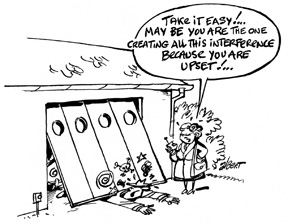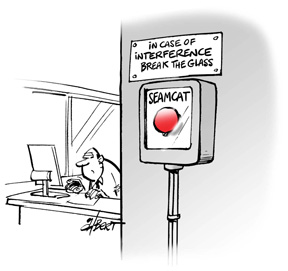The role of Spectrum Engineering: an essential element to using spectrum efficiently
Googling “Spectrum Engineering” gives you 42,500,000 hits in 0.18 seconds. Adding “use spectrum efficiently” to the search returns 54,300,000 hits. This exercise is not strictly scientific, but it clearly indicates how relevant the role of spectrum engineering is in a world where it is commonly accepted that the radio spectrum is a limited resource and so must be used optimally.
If you want to apply 'good' spectrum engineering practice you will eventually be deriving the optimum separation (either in space or frequency) between a 'victim' system and the interfering radio systems. This should allow both the victim and the interfering system to work by minimising operational restrictions but also preventing interference that degrades radio applications' performances. The challenge of using the spectrum efficiently is not as trivial as it sounds. It encompasses on one hand the increasing penetration of the existing radio applications or the introduction of new radio applications and on the other hand the protection of existing services from interference. This balance has to consider regulatory, technical and economic aspects at national and international level.
The more harmonised the frequency bands are between the 48 member states of the CEPT region, the more efficient the spectrum becomes for the benefit of the European market. For these countries to optimise the usage of the spectrum nationally or across borders, they need to have regulations based on clear technical guidelines¹. The electronic committee of the CEPT, the ECC, has long understood the importance of spectrum engineering. The Spectrum Engineering Working Group (WGSE) is responsible for investigating spectrum engineering matters.
It is composed of radio spectrum engineers from the CEPT administrations and also from the European industry that sit at the same table and share their experiences and expertise. Their work is consensus driven and creates the solutions for harmonising the radio spectrum through the CEPT countries based on open and transparent technical studies.

These range from dealing with mobile systems operating below 3 GHz (though IMT is considered by a separate group), space services, short range devices, fixed services, to new applications like cognitive radio. Needless to say that spectrum efficiency cannot be achieved without open communication and cooperation with the relevant European standard bodies like ETSI. WG SE's work also includes the creation of many of the ECC's 'CEPT Reports', prepared under mandate from the European Commission, and used in spectrum regulation which is binding on the 27 EU member states.
Nowadays, a lot of the electronic devices you manipulate use radio transceivers. To give just a few examples, think of your car keys, baby alarms, toll system as you drive along the bridges, tunnels and many of the motorways connecting Europe together or even down to the “wireless” door bell at 9.99 Euros at the nearest 'Do It Yourself' store. All of these applications or systems have, at one point or another, been under the scrutiny of radio experts like in PT SE24 for short range devices (SRDs) to study their feasible applicability for public usage. In what is called 'unlicensed' spectrum² (where most of the SRDs operate) technical rules3 (i.e. power level, spectrum access, mitigation requirement, channel spacing) are set to prevent or mitigate the interference so that the spectrum is used as efficiently as possible. Otherwise you end up with a spectrum that is simply un-usable.
Another example of WGSE's work, perhaps less obvious to the public, is the guidance produced by PT SE7 to improve the coexistence between GSM-Railway network4 and the well known public GSM cellular network. The work identified some of the measures which may be necessary to solve interference cases that may occur on a local/national basis. This approach allows national competences to apply additional spectrum engineering techniques for local site coordination when appropriate. It is a real example where the ECC sets strategic guidance but where the national regulators are eventually responsible for licensing and enforcement, and operators have responsibility to implement.

Spectrum efficiency can nowadays only be achieved when the engineering assumptions are prepared with state of the art spectrum software tools. You have many ways of analysing compatibility or coexistence criteria. One methodology called Monte Carlo5 is widely used for the simulation of random processes based on statistical variables. For spectrum studies, a radio device is described by a series of variables (i.e. antenna height, power etc.) and when statistics are generated with sufficient confidence, the performance of 'real' life devices under specific interference mechanisms can be predicted. WGSE chooses the pragmatic approach to freely distribute the software called SEAMCAT6 (maintained by the ECO). This results in a European tool used world-wide (i.e. within but also outside the CEPT region) that allows you to perform independent compatibility studies where the cost development of such a spectrum tool is shared between European partners.
Finally, spectrum regulations are not carved in tablets of stone. There is a constant need for technical studies to assess how new technologies or enhanced existing technologies can use the spectrum, and so benefit the European citizen. In order to maintain continuous European spectrum harmonisation in these days of economic recession, the European industry and administrations need to ensure a continued supply of competent and imaginative spectrum engineers to respond to the challenge of making efficient use of the radio spectrum in the long term.
Jean-Philippe Kermoal,
ECO Expert in Spectrum Engineering
¹These technical guidelines can be ECC Recommendations, ECC or CEPT Reports.
²In an “unlicensed” spectrum band, the users of the band can not claim protection from interference,
therefore generic regulation and “self-discipline” is required.
³See ERC/REC 70-03.
4GSM-R is used by the railway network operators for maintaining their railway infrastructure e.g. control command and signalling (see ECC Report 162).
5The term “Monte Carlo” methodology was coined in the 1940s by physicists working on nuclear weapon projects in the Los Alamos National Laboratory (USA).
This approach was used for solving statistical problems; the code name given to the work was Monte Carlo.
6Spectrum Engineering Advanced Monte Carlo Analysis Tool
(http://cept.org/eco/ecc-tools-and-services/seamcat)
